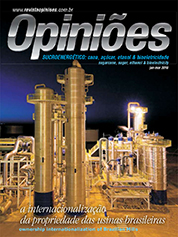Umberto Grohmann Ortolan
Senior Project Manager of Banco Rabobank
Op-AA-23
Internationalization as a tool for growth and increase in productivity
In the past five years the Brazilian sugar and ethanol industry experienced strong expansion originated by accelerated growth of the sugar market (due to consumption increase in developing countries, the elimination of Europe’s subsidized exports, and the consolidation of Brazil as the world’s main exporter) and due to an explosion in the ethanol market (“flex cars” in the Brazilian market and the promise of biofuels in the world).
One should emphasize the recent approval of Brazilian ethanol as renewable low carbon biofuel by the US Environmental Protection Agency (EPA), a fact that may facilitate the entry of the fuel in the USA. All this growth creates, and will continue to create, profitable opportunities to invest in the production and logistics of these products, attracting Brazilian and international capital to the industry, the latter specifically more intensively after Brazil obtained the investment grade rating.
As a natural selection process, this capital is available for investment in well prepared and efficient companies and for the acquisition and operational restructuring of less prepared companies. Thus, in seeking access to such capital, participants in the sugar and ethanol industry are experiencing a transformation process that encompasses among others:
1. Consolidation and gains in scale: The industry is still very fragmented, however the ten largest groups today process crushing volumes in excess of 10 million tons of sugarcane per harvest, with the two largest volumes in the range of 30-60 million tons;
2. Elimination of intermediation/vertical integration: large groups and associations have made inroads in logistics (terminals, railroad logistics, pipelines and ports), sales and distribution, assuring production flow;
3. Professionalization: Family-managed structures are still very present, but are gradually being replaced by professional management. Universities have developed graduate courses especially suited for the industry’s needs;
4. Formalization and transparency: Noteworthy development in the number of mills audited by first class companies for greater transparency for the market, particularly creditors. On this issue, one should also mention organizational restructurings occurring so as to prepare companies for receiving funds from abroad (IPOs, private equity, and others);
5. Access to the capital market: The first capital market access wave occurred in 2007, with the public issuance of shares and the granting of loans. Additionally, in the market there are several companies strongly suited to access the capital market in the next two years.
This transformation generates benefits by creating larger and more capitalized companies, equipped to undertake the investments necessary in Brazil and abroad, at the pace required by consumers and the safety demanded by investors. In this context, the internationalization of ownership of Brazilian mills by multinational companies, funds and other direct forms of investment is a complementary but essential factor in achieving the speed at which such transformations occur, resulting in growth and productivity.
Internationalization as such does not cause major impact on small size groups and isolated mills, however the broader transformation process that takes place, in the long run creates difficulties for the survival of such groups with smaller production scales and lower efficiency. Naturally, this is a transition process expected to last several years, allowing mills to prepare for competition in this new environment.
It is important to point out that there is no barrier to creating large Brazilian companies, competitive in the international market, as has occurred in other industries, including agribusiness. Several Brazilian companies have the potential and the ambition to strongly participate in the industry’s consolidation process and in the international expansion in sugar refining and the commercialization/distribution of sugar and ethanol.
This process will depend on the understanding among Brazilian companies in the industry and public incentive policies for creating green and yellow (Brazil’s colors) multinational companies. Until then, major growth and consolidation movements in the industry will take place probably caused by international capital, as in the cases of LDC/Santelisa Vale, Bunge/Moema, and Shell/Cosan. Welcome to internationalization, investments, growth and productivity.




